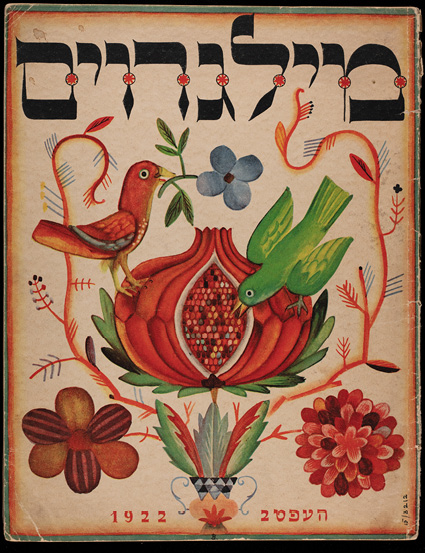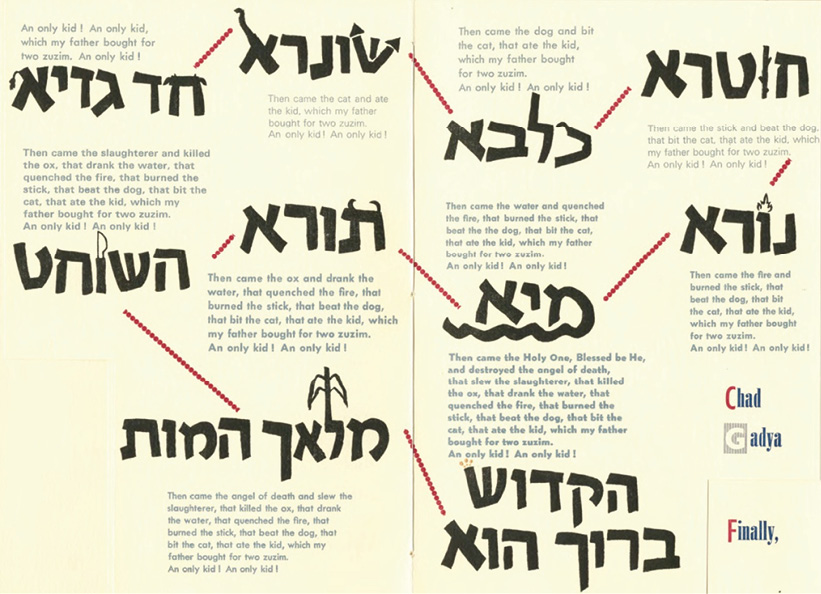The Materiality of the Book in Yiddish Modernism: An Essay
The Materiality of the Book in Yiddish Modernism: An Essay
The book is a central modernist genre, and nowhere is the art of the book more evident than in the exuberant work of interwar Yiddish culture. Books, and the related example of the little magazine, were the locus of multilingual, avant-garde experimentation in cosmopolitan settings across Eastern and Central Europe. Historically, the idea of “the Book” occupies a central place within Jewish religious cultures, and some of this condition seems to have seeped into the production of ostensibly secular forms, works created by Jewish authors and artists as traditional religious practices came aground on the shores of modernity.[1] As part of modernist movements such as Objectivism, Constructivism, Suprematism, and Expressionism, Jewish writers and artists brought sensitivity to the word as such to bear on modernism’s particular devotion to image-text relations. Indeed, Yiddish little magazines, as well as books and prints by figures such as the Russian artist El (Eleazar) Lissitzky (1890–1941), showcased the meeting of reverence for the book’s “aura” (in Benjaminian terms) with the New Typography’s treatment of the word and the alphabet as iconic forms.
Lissitzky’s Khad gádye (One kid; Kiev, 1919), a relatively modest book, is an essential station in the history of Yiddish print and modern Jewish literature and, given Lissitzky’s stature and influence as an artist, designer, and typographer, possibly also in the entire trajectory of twentieth-century art.[2] This is quite a burden to place on a colorful set of lithographs illustrating a nonsense song about animals; the song “Khad gádye” was printed simultaneously in Aramaic and in Yiddish in the sixteenth-century Prague Haggadah and is traditionally sung at the end of the long Passover meal. The text is not even considered a part of the traditional liturgy and is viewed as a kind of add-on, whose melodic concatenation of verses linked in associative style helped keep children awake. Lissitzky’s first edition of seventy-five copies collected his whimsical prints inside a triple-folded dustcover with an insignia (also designed by Lissitzky) from the Yiddish publishing house Kultur-Lige. A black-and-white edition of one thousand copies (Warsaw: Kultur-Lige, 1923) was subsequently published. Each page features a verse from the song and a rendering of the actions of the animals; these illustrations are both abstract and folk, reflecting the diverse influences shaping the work of Eastern European Jewish artists.[3] Of special significance for Lissitzky was an ethnographic trip that he took with fellow Yiddishist Issachar Ber Ryback. They visited old wooden synagogues across the Ukraine and sketched their colorful wall paintings: expansive and kaleidoscopic murals with natural motifs and ornamental patterns, many of which incorporated inscriptions with Hebrew lettering.[4] An impression of these rich visual artifacts may be observed in Lissitzky’s drawings, both in the ornate, art nouveau style and in the increased attention to typography. Lissitzky recalled these spaces as rich visual texts: “Every synagogue has a small library. The cases hold some of the oldest editions of the Talmud and other religious texts, each with front-pieces, decorative devices and tailpieces. These few pages fulfilled the same function in their time as illustrated journals do in our own day: they familiarized everyone with the art trends of the period.”[5] Lissitzky compares ancient Jewish religious volumes to the era’s numerous little magazines, in which he and other contemporary artists debated the existence of that ever-elusive Jewish style: architectural forms and Hebrew letters (space and text, respectively) became a kind of protovocabulary for that project. What began as ethnography, an exploration of local folkloric material and artistic practices, eventually evolved into an avant-garde abstract language.

figure 1. Albatros 3–4 (Berlin, 1923).
Courtesy of the Library of the YIVO Institute for Jewish Research.

figure 2. Milgroym (Berlin, 1922).
Courtesy of the Library of the YIVO Institute for Jewish Research.
Lissitzky’s Khad gádye is a multilingual book, incorporating Hebrew letters as numbers, phrases from Aramaic prayer, and the full song in Yiddish, perhaps a nod to its familiarity to readers.[6] The Hebrew alphabet is treated as a pictorial, iconic form. Today we may take for granted the appearance of Hebrew print in a variety of typographical forms; Khad gádye appeared during a time of new experimentation with fonts and typefaces, notably in Berlin’s publishing houses and artistic journals but also driven by Lissitzky and his peers.[7] Khad gádye emblematizes a growing sense that Jewish books can and should possess an aesthetic design, with typography as a key element therein. This focus on letters also exemplifies the avant-garde’s broad interest in the alphabet’s visual form, features that could be produced and combined in innovative fashion. The shading and crosshatching of some of the letters — they look almost like stencil forms — draw our attention to their status as sketched figures. The introduction of architectural forms to the design of books also shaped both typography — the spacing and look of letters — and layout. Within Khad gádye, each page appears to be framed as a kind of architectural space, with the main text arching above the drawings and across the page. Some of these pages, with their relatively figural though incomplete drawings laid over geometric blocks of color, seem to constitute a kind of “argument” with the looming presence of Marc Chagall, one of Lissitzky’s mentors at the Vitebsk Art Academy: the little houses, the whimsy and motion of the figures, the animal fable interacting with Cubist forms, all recall Chagall’s famous I and the Village (1911).

figure 3. Artist’s book by Lynne Avadenka, An Only Kid (1990).
Courtesy of the artist.
Lissitzky’s other Vitebsk mentor was the Suprematist Kasimir Malevich, and the book’s distinctive dust jacket was likely Lissitzky’s most proto-Constructivist work to date: the attention to geometric design, engineered by the artist, marking the beginning of what would eventually emerge as his idea of “Prouns,” a Constructive form between collage and object, that pointed resolutely toward the new.[8] Lissitzky’s contemporary Henryk Berlewi memorably described this combination of styles — roughly, the distance between Chagall and Malevich, in which the Lissitzky of Khad gádye occupied an increasingly tenuous middle — as an amalgam of “Russian luboks, old Jewish murals and Cubism.”[9] Indeed, Khad gádye resembles the colors and folk themes of traditional Russian woodprints, many of which also offered oblique allegorical commentary on the vagaries of power.
Both Lissitzky and Berlewi accomplished significant early work in Yiddish before becoming major exemplars of abstraction and typographic innovation in other languages, such as German and Polish. Their Jewishness, their beginnings as Yiddish writers and artists, sensitized them to the iconic properties of the letter as such, given the variant alphabets and the normative aversion within traditional Judaic religious culture to certain kinds of visual forms. Perhaps we may understand their interest in abstraction as an exercise in acculturation, an expression of a desire for the gradual disappearance of national cultures and the rise of some universal artistic language; and as an aesthetic practice, since abstraction is potentially more “communicative,” more universal, allowing work by these Jewish artists to be more easily absorbed into the international modernist pantheon. Ironically, what was perceived as Judaism’s “handicap” in relation to artistic forms — its resistance to figuration — precipitated an evolution away from it. Note also that Khad gádye was one of the last works signed by the artist with his given (Hebrew) name Eleazar, after which he visually reduced his first name, aptly, to something resembling a single alphabetical form, indicating perhaps a formal farewell to the theological origins of both the name and his earliest aesthetic affinities. Eventually, abstraction was perceived as more sophisticated than figuration, and also more “worldly,” especially in relation to the emergent connection between Hebrew and Zionism that shaped other literary production in this period. (This very same feature was, of course, later tragically used to lambaste Jewish artists as “degenerate” and not sufficiently national.)[10] In this way, we can appreciate Lissitzky, and Yiddish modernism’s engagement with abstraction, as not simply “a part” of something broader (e.g., European avant-garde modernism) but in fact among its conceptual architects.
Lissitzky’s Khad gádye remains a touchstone within Yiddish modernism, modern Jewish literature, and the history of book art: a beloved, playful yet menacing text coupled with the artist’s tour-de-force orchestration of “Russian Luboks, old Jewish murals and Cubism.” Its subsequent appropriation and reinterpretation by artists and bookmakers brings us back to the idea of “the Book” in powerful and surprising ways.[11]
endnotes
-
On the meaning of material sacred forms for the emergence of secular literary genres, see Barbara Mann, The Object of Jewish Literature: A Material History (New Haven, CT: Yale University Press, 2022). ↩
-
See Arnold Band, ed., Had gadya, The Only Kid: Facsimile of El Lissitzky’s 1919 Edition (ReSources), with an introduction by Nancy Perloff (Getty Research Institute, 2004), https://d2aohiyo3d3idm.cloudfront.net/publications/virtuallibrary/089236744X.pdf. ↩
-
See Alexander Kantsedikas, El Lissitzky: The Jewish Period (London: Unicorn, 2017). ↩
-
On Ryback and Lissitzky, see Hillel Kazovksy, “The Art Section of the Kultur-Lige,” Jews in Eastern Europe 3, no. 22 (1993): 5–22. ↩
-
Excerpt from his memories of this trip from “Vegn der Mohilever shul” [The Mohilev synagogue: Reminiscences] originally appeared in the journal Milgroym, 1923, translation in Kantsedikas, El Lissitzky, 152. ↩
-
Samuel Spinner, “Reading Jewish,” PMLA 134, no. 1 (2019): 150–56. ↩
-
For a detailed and expansively illustrated treatment, see Gil Weissblei, Teḥiyata shel omanut ha-sefer ha-‘ivri be-republikat Veimar [The revival of Hebrew book art in Weimar Germany] (Jerusalem: Carmel, 2019). ↩
-
For El Lissitzky’s vision of art as both pragmatic and creative, see his “Overcoming Art,” Ringen 10 (1922): 32–34. An abbreviated translation from the Polish appears in Timothy O. Benson and Éva Forgács, eds., Between Worlds: A Sourcebook of Central European Avant-Gardes, 1910–1930 (Cambridge, MA: MIT Press, 2002), 186. ↩
-
Henryk Berlewi, “Jewish Artists in Contemporary Russian Art” (1922), trans. Rachel Field, In geveb, February 2018, accessed August 23, 2018, https://ingeveb.org/people/h-berlevi. ↩
-
On the problem of abstraction for Jewish artists in this period, see two articles by Seth Wolitz, “Between Folk and Freedom: The Failure of the Yiddish Modernist Movement in Poland,” Yiddish 8 (1991): 26–51; and “The Kiev-Grupe (1918–1920) Debate: The Function of Literature?,” Yiddish 3, no. 3 (1978): 97–106. Both essays are reprinted in Seth L. Wolitz, Yiddish Modernism: Studies in Twentieth-Century Eastern European Culture (Bloomington, IN: Slavica, 2014). ↩
-
See Frank Stella, “Had gadya” after El Lissitzky (1982–84); and Lynne Avadenka, An Only Kid (1990). ↩



